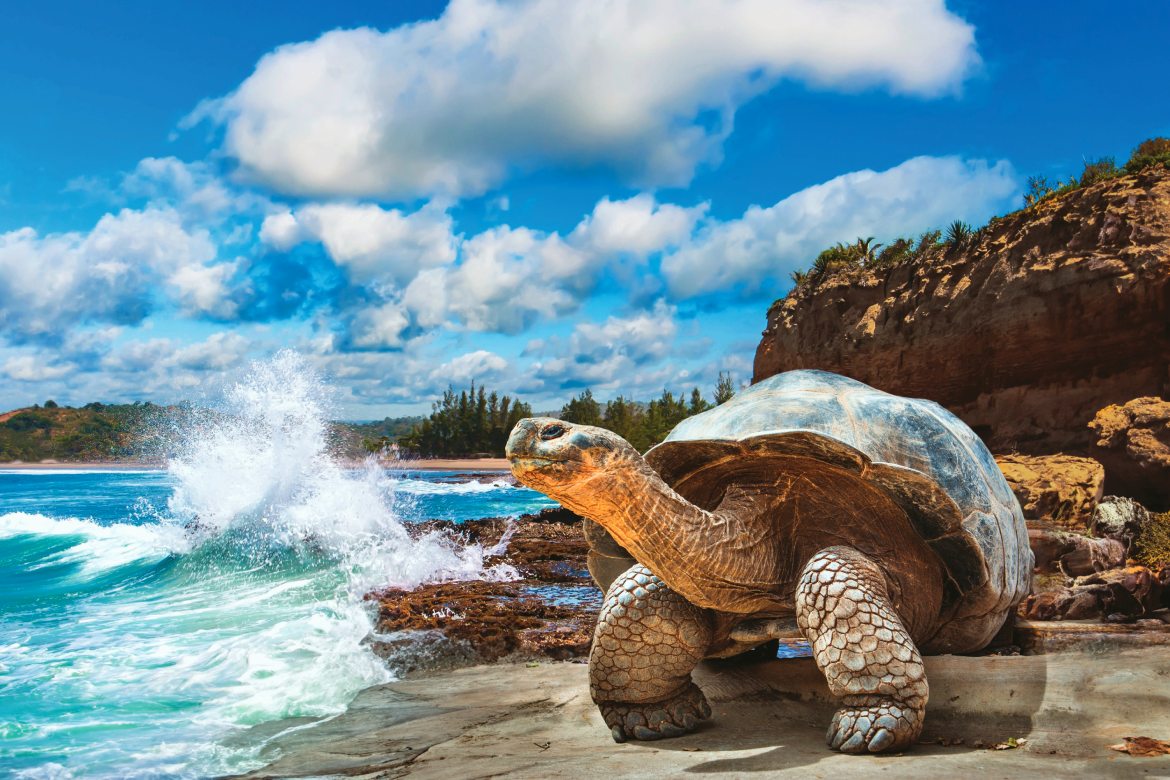The Galápagos Islands have long been heralded for their rocky, volcanic shorelines teeming with rare, endemic wildlife, and visitors to Ecuador’s far-flung archipelago will discover natural beauty everywhere they go!
To my left, a descending staircase wiggles with sleepy sea lions nursing their young. To my right, the ash-black scales of marine iguanas cling to the warmth of seaside rocks in the late afternoon. I peer over a metal guardrail and fixate on a trio of young reef sharks weaving their serpentine way across the marina. It’s my first day in the Galápagos, Ecuador’s far-flung, eastern archipelago, wildlife is everywhere, and I haven’t even left town yet.
The Galápagos Islands have long been heralded for their rocky, volcanic shorelines teeming with rare, endemic wildlife. To understand their remarkable present, it’s important to look back at their complicated past. In the 17th century, the gaggle of islets was a known stomping ground for pirates lying in wait to raid Spanish galleons. The famous giant tortoises that reside across much of the landmass were also considered an important and reliable food source for early buccaneers looting the known trade routes.
In the late 1700s, European whalers had so dramatically decimated the population of large Atlantic cetaceans that they began hunting in the Pacific waters surrounding the Galápagos, returning home with hundreds of tons of whale oil and seal skins. This shift in the global oil trade further impacted the islands’ delicate ecosystem, introducing over 1,400 invasive species of non-native plants and animals, and hugely reducing the numbers of fur seals, tortoises, lobsters, and groupers. If you visited the Galápagos today, you’d likely never know.
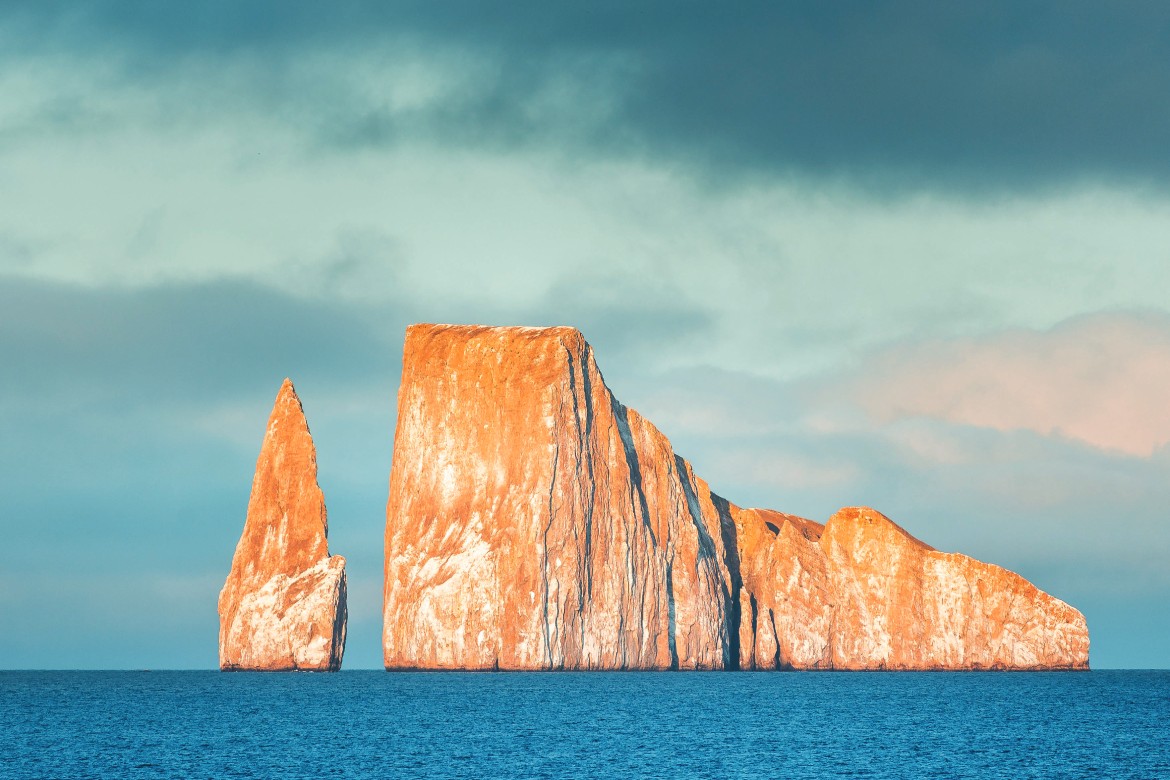
Kicker Rock (Photo by Laidback)
In 1936, the Ecuadorian government declared the archipelago a natural reserve and, along with big-name NGOs like the World Wildlife Fund, the International Union for the Conservation of Nature, and UNESCO, began pouring resources into the islands to come up with an appropriate and lasting conservation strategy. By 1959, the area was designated as a national park, with 97 percent of the land dedicated to the preservation and protection of endemic species and the remaining 3 percent staying in the hands of colonizers and villagers. It’s one of the greatest conservation success stories ever told.
To get to the Galápagos, most travelers will first have to fly into Quito, Ecuador’s capital city. Set at a lofty altitude of 9,350 feet above sea level, the bustling metropolis is delightfully European, with rose-pink facades, arched frescos, and centuries-old cathedrals, complete with steepled bell towers. I elected to stay in the town’s stylish La Mariscal neighborhood, home to delectable restaurants surrounding Plaza Foch (be sure to walk over to Miskay (miskay.ec/en) for a dose of authentic local cuisine), charming artisan shops, and a gay-friendly late night scene.
After perusing the internet for the perfect place to stay before my island adventure, I happily booked a room in the romantic vintage digs of Casa Joaquin (hotelcasajoaquin.com), which is a local, queer owned boutique hotel with a fabulous breakfast included. After checking in with the friendly host, and practically drooling over the adorable tufted headboard inside my suite, I wandered the cobblestone streets of “la zona rosa” (the city’s LGBTQ+ nightlife area) and grabbed a drink at Radar (facebook.com/Radar.bk), a sort-of house-turned-queer-discoteca and drag show venue. The liquor was cheap, the crowd felt young and festive, and the dance floor was just starting to heat up when I looked at the clock and suddenly realized that I needed to dash to bed. I had a 5 A.M. wakeup ahead of me if I was going to make my flight to the Galápagos.
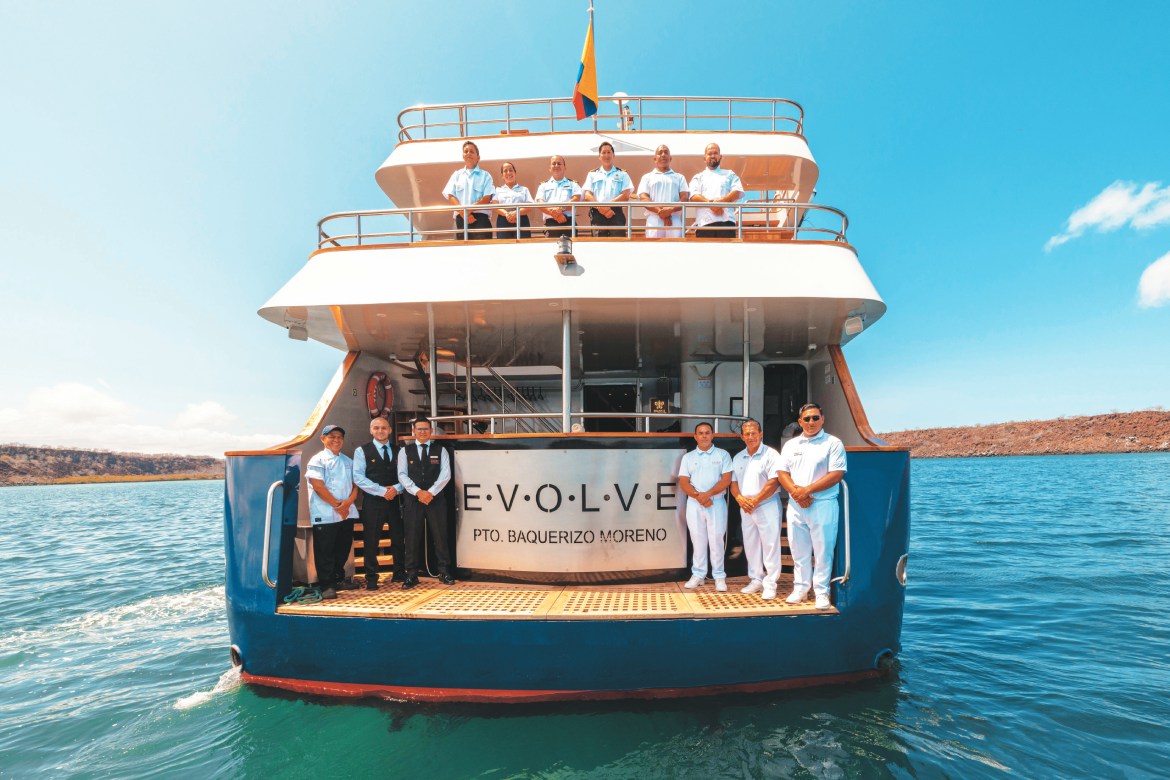
Evolve Crew on the stern (Photos by ecoventura)
My hosts for this adventure was Ecoventura (ecoventura.com), one of the top purveyors of luxury small-ship cruises around the Galápagos, and I was thrilled to be spending a full week with their expert team of naturalists and top-notch service staff. Our boat, the newly-christened Evolve, was a shining example of what makes small boat journeys so magical, especially in a place like the Galápagos. I’ve never considered myself a “cruise person,” but here, on a vessel that can only house twenty guests, I could see the appeal. Staterooms were elegant and squeaky-clean, dinners were three-to-four courses of bliss, the rooftop deck and bar were never crowded, and the one-on-one knowledge sharing and snorkeling help I experienced surpassed all other cruises. Plus, the regulatory boards that help control the number of tourists allowed at each wildlife-centric site every day (visitors must be accompanied by a guide at all times) can more effectively manage and protect the park from overcrowding when travelers arrive via one of these small, luxe yachts. Win, win.
First up in our conservation education? La Galapaguera, a remote preserve in the highlands of San Cristóbal where the island’s legendary giant tortoises are bred and protected, but allowed to roam free. Led by the two knowledgeable naturalists who would be our guides for the week, Sofia Darquea and Fernando Sanchez, our small group meandered along a series of short trails, pausing to marvel at the enormous, grandfatherly reptiles as they galumphed around, eating grasses.
“If you remove the tortoises from any of the islands, the ecosystem will collapse within just a few years,” Sofia said as we all crouched to snap the perfect photo of a hard-shelled, hundred-year-old creature. “Because everything is connected.”
I thought about this sentiment after dinner that night, lolling in the rooftop hot tub with a drink in hand as I listened to the far-off echoes of barking sea lions. I was eager to see what fresh ecological wonders the rest of the week might bring.
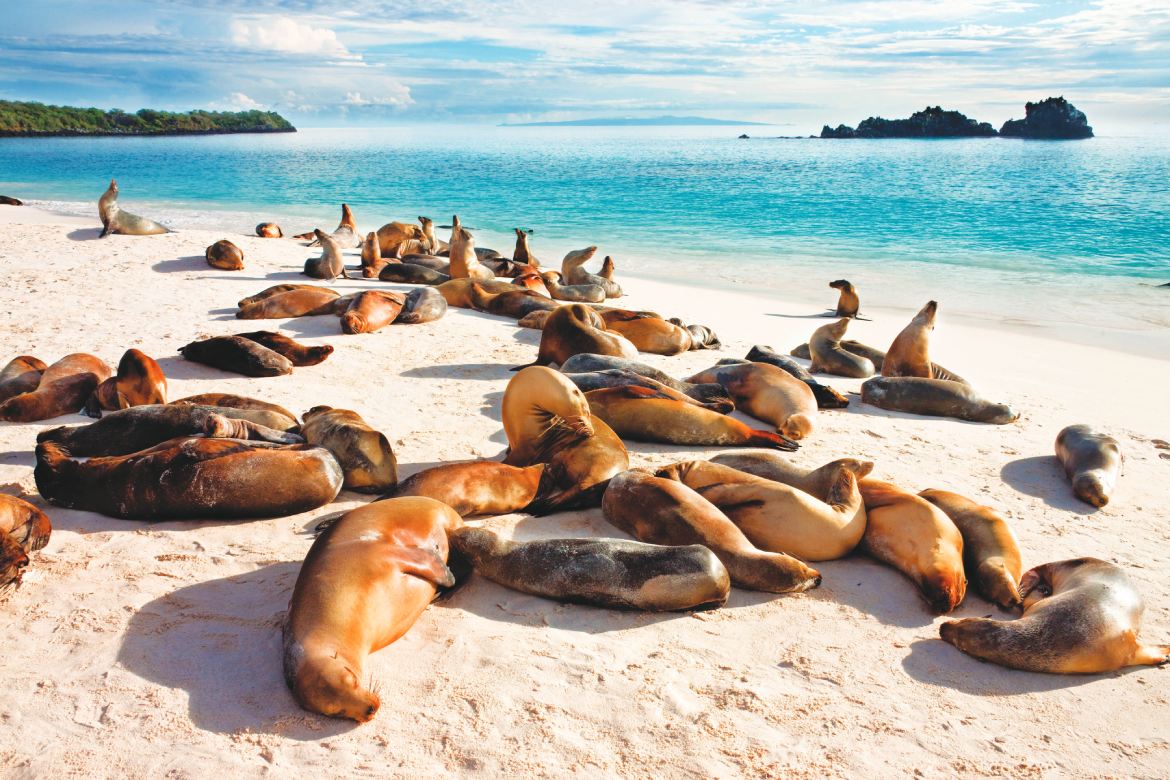
Sea Lion Colony at Gardner Bay on Espanola in the Galápagos (Photo by Steve Allen)
The Galápagos Islands are truly unlike any protected area I’ve ever encountered. They are a rich tapestry of unique environments for both wildlife and geology lovers to discover as they explore with a guide.
Ecoventura’s “Beaches and Bays” itinerary takes ample care to split its time between the extraordinary wildlife found in the area’s southern and central islands and the otherworldly volcanic landscapes and secret swimming coves the archipelago is known for. On my second day aboard the Evolve, I rose early for a buffet-style breakfast of eggs, pancakes, and orange juice, and, if I’m being honest, multiple cups of coffee to amp myself up for the day’s myriad activities.
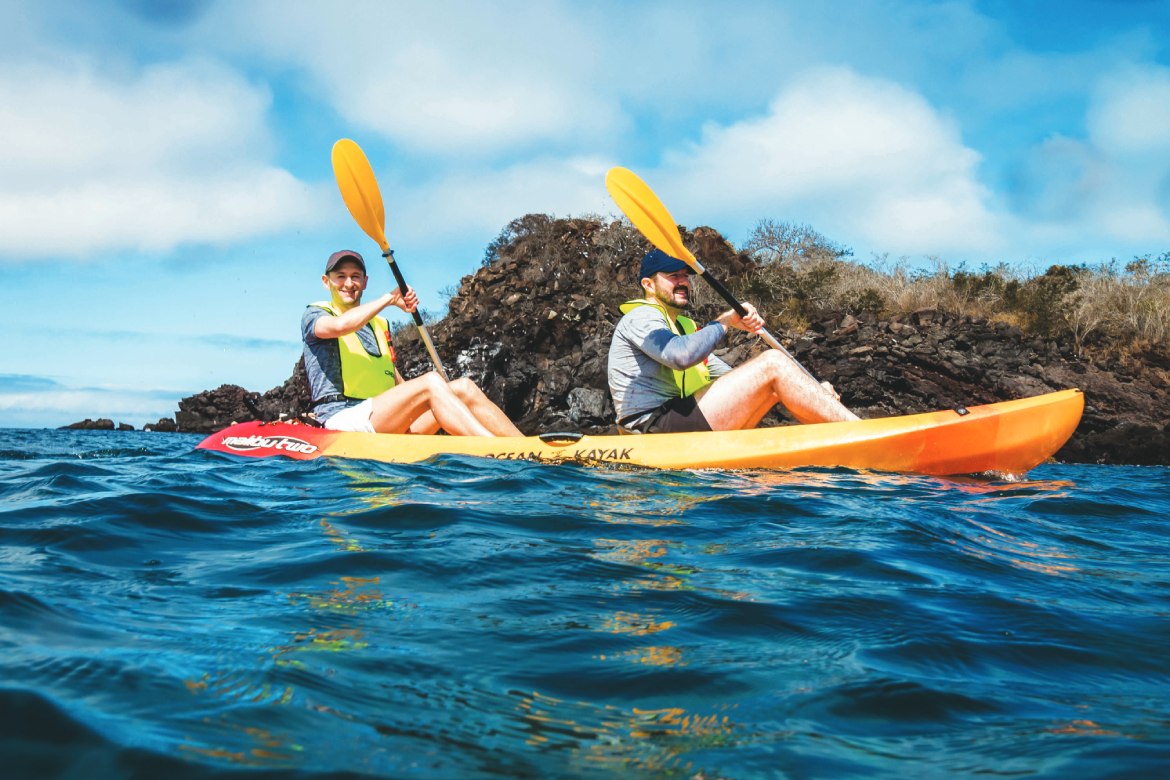
Kayaking in the Galápagos (Photo by Ecoventura)
Anchored off the coast of the auspiciously-named Cerro Brujo (that’s Witch Hill in Spanish), I boarded an inflatable dinghy, called a panga, and set off on a small group tour of the rugged coastline. Along the way, we gazed intently at brilliant red crabs scuttling their way across near vertical cliff faces, motored through a huge, light-soaked rock arch, and paused for a long moment to admire a blue-footed booby preening itself on a rock beside an unruly pelican.

Blue Footed Booby Galapagos (Photo by Emily Pennington)
Afterwards, our group landed on the nearby white sand beach, strolling past statue-still marine iguanas baking in the late morning sun and quick moving ghost crabs that darted back into their burrows as soon as a human ventured too close. I dipped my toes into the warm surf and cruised over to an outcropping of black lava rock, where several baby sea lions anxiously waited for their mothers to return with more food. Some flopped around in the sand, pretending to nap, while others squiggled and squirmed and awkwardly scooted to and fro, as if performing for the cameras. I fell in love with their humongous black eyes and feisty personalities, their lack of grace, and their frenetic search for anything to quell the boredom before mom came home with milk.
“Our wildlife here is very naïve,” Sofia said, explaining why most animals in the Galápagos don’t flee when approached and why it’s important to maintain a six-foot distance from them at all times.
“Because humans only arrived to these islands a couple hundred years ago. They haven’t had the time to adapt with the proper fear.” It was a strange and ancient feeling, being able to walk among so many animals I had only read about in books, so close to their legendary faces and without fear of predators (none are native to the islands).
The afternoon’s murky snorkeling session left me shaky and off balance from the powerful waves, but an early-evening two-mile hike at Punta Pitt turned the day around, as Fernando led my group of eight up and around towering amber mountains of volcanic tuff. The hot, humid air added a strange, almost tropical quality to the arid, desert-like environment, but as we stomped our boots upward, our guide began to point out hidden wonders in the hills’ scraggly trees.
The site was known as a top-notch place for bird watching, housing a breeding ground for rare red-footed boobies. Nestled into thick branches here and there were tangles of nests, each with a fluffy white marshmallow of a chick waiting patiently for its parents to return. Large, black-winged birds soared overhead, coasting on high thermals, and, hundreds of yards away, we witnessed a pair of blue-footed boobies performing their courtship dance, flexing their namesake webbed appendages as they circled each other and sky-pointed in a calculated dance.

Marine Iguana with Blue Footed Boobies on Isabela island Galapagos (Photo by Reisegraf.ch)
Per usual, dinner was a locally-sourced feast that exceeded my expectations, and I went to bed stuffed on homemade spinach ravioli, prawn bisque, white fish with fluffy coconut rice and fresh vegetables, and crème brûlée for dessert.
Of all the famous scientists to explore the Galápagos Islands, none has had a greater impact than Charles Darwin. At a mere 22 years old, he first visited the archipelago aboard the H. M. S. Beagle, as the ship’s naturalist. While on the islands, he took geological and biological samples of various rocks, plants, and animals, but it was only later, when reviewing his data, that he noticed keen variations among three different species of mockingbirds, spread across three different islands. He published On the Origin of Species in 1859, twenty-eight years after his initial voyage, and it shaped the way we view evolutionary change forever. It was deemed that “natural selection,” rather than “special creation,” was the primary cause of transmutations among species, and that each plant and animal had evolved specifically to adapt to its surroundings, a phenomenon that was slightly easier to witness in the Galápagos, with its abundance of unique, endemic inhabitants.
I rose from bed for a breakfast of granola, acai, and fresh fruit, enjoyed with a backdrop of panoramic views atop the Evolve’s stunning rooftop terrace. Our third day’s mission was a stroll across Española Island, with its fuchsia and teal Christmas iguanas, rainbow colored Sally Lightfoot crabs, and sprawling breeding colony of bright white Nazca boobies. At the end of our trek, saltwater erupted from a blowhole in a nearby formation of craggy volcanic rock, and I found myself utterly awestruck by the thousands of up-close wildlife encounters I had experienced in only two hours.
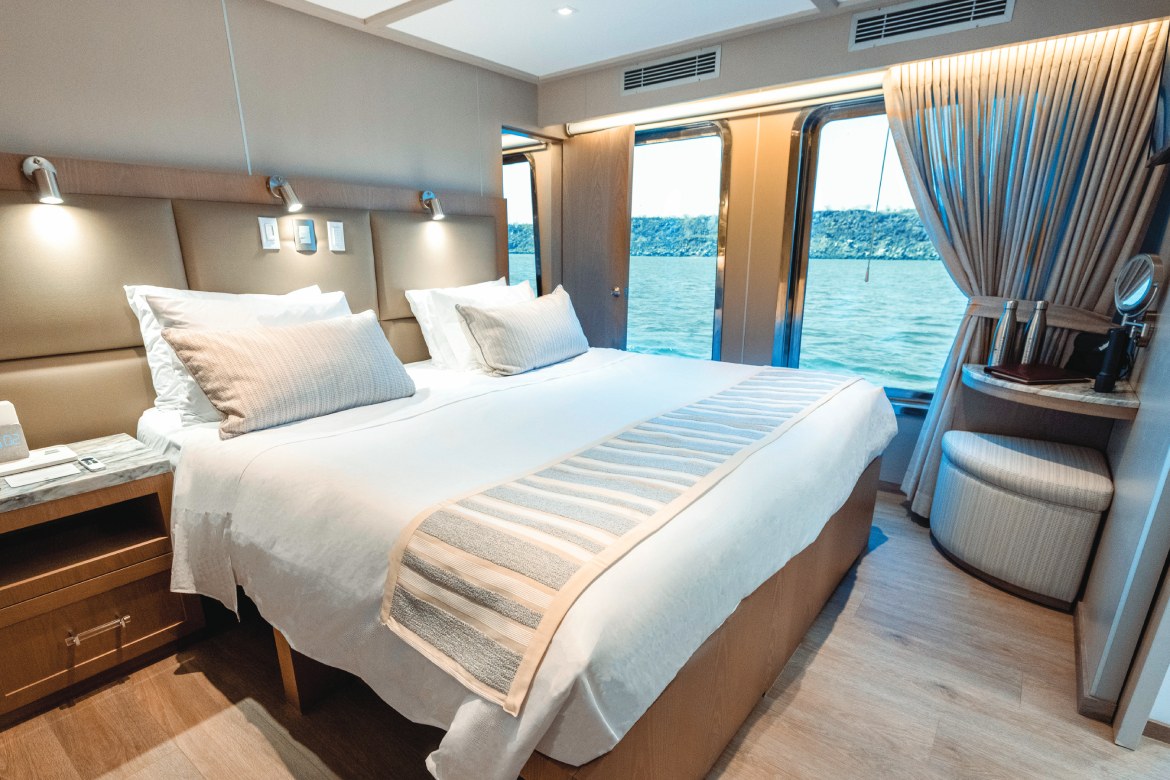
Evolve Cabin (Photos by ecoventura)
Lunch was punctuated by a ceviche-making lesson, after which we took yet another panga boat ride to snorkel near Gardner Bay, which is one of the best places in the Galápagos to swim with frisky sea lions. The location did not disappoint, and, though the coral life among these islands is often in short supply, the waters are just as rich as the land when it comes to interesting fauna. Curious, yearling sea lions darted back and forth along the coastline, curiously eyeing our group with the motion-packed intensity of a toddler. The way each pinniped shot across the ocean was breathtaking in its grace, like flying underwater. My evening wound down with a sunset walk along the neighboring white sand beach, the white visage of the Evolve fading as the neon sun sank low.
Day five was quite different compared to the idyllic wilderness explorations my crew had amassed thus far. It was time to switch gears and do a little souvenir shopping in Puerto Ayora, the largest town in the Galápagos, set on the eastern shore of Santa Cruz Island. We took a bus deep into the highlands to saunter among giant tortoises, then visited the Charles Darwin Research Station to see, first-hand, how their babies are carefully bred and raised in captivity.
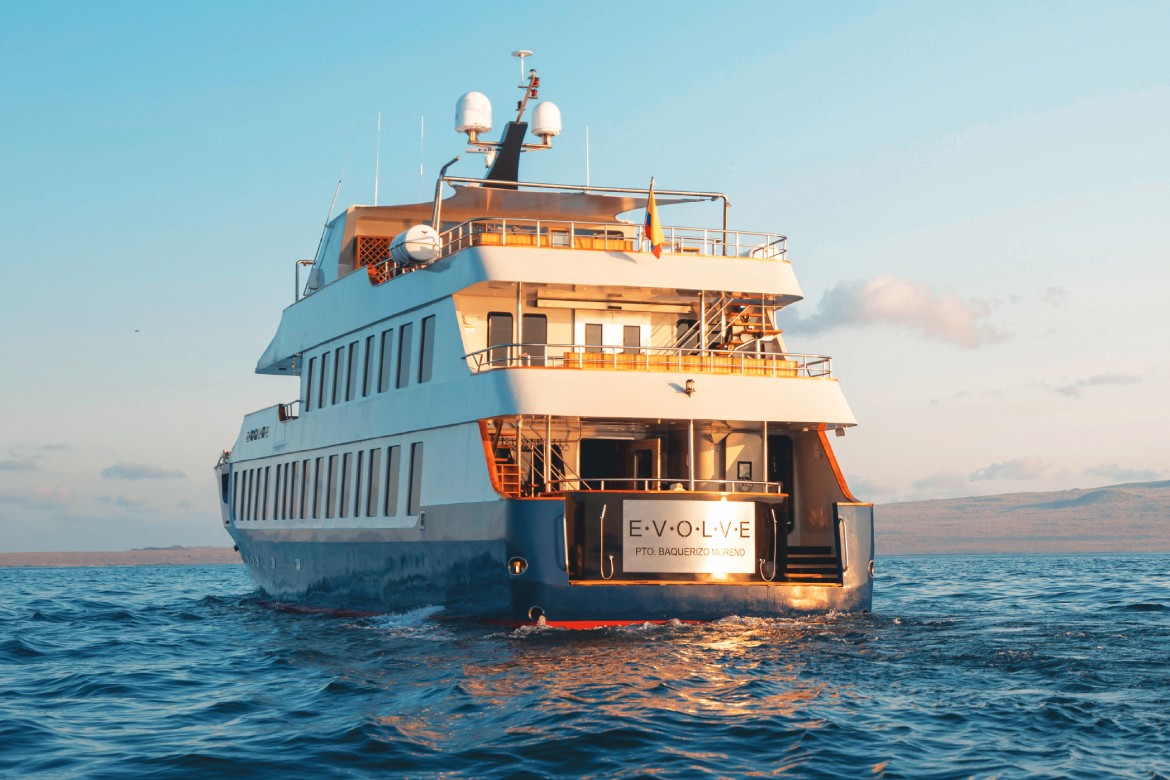
Port side of the Evolve stern (Photos by ecoventura)
After all the hubbub of city life ricocheting back into my consciousness, I was pleasantly surprised to find that I woke the next morning to a gauzy, mauve sunrise near Bartolomé Island, with only two Ecoventura ships in sight. Sofia, the naturalist, led our group up a long series of stairs and wooden boardwalks to a postcard-worthy overlook that allowed us to gaze out at the rust-red soil, bright green foliage, and rounded cinder cones that make the islet so unique, and one of the most-photographed places in the entire archipelago.
But the real treat came in the afternoon, when we donned our (very attractive) snorkeling gear and dipped our bodies into the cerulean seawater to parallel the jagged shoreline for an hour in hopes of spotting some psychedelic-looking parrotfish. Faster than I could comprehend, a small, black and white torpedo zoomed past me, followed by another. They were penguins! The wondrous Galápagos penguins that I’d heard so much about.
Not only are these flightless birds the only species of penguins known to live near the equator, they’re notorious among travelers to the islands for adding an unexpected dash of personality to any visit. I tried my best to remain buoyant, as I flapped my fins up and down to keep up with the little speed demons. Angelfish and white tipped reef sharks floated by as our group swam back towards the pangas. I didn’t think there was any way our last day onboard could possibly top this.
The following morning, on South Plaza Island, we hiked past prickly pear cactus trees and land iguanas, just beginning to turn bright orange for mating season. We saw red-eyed swallowtail gulls feeding their tiny chicks, and we watched ferocious waves crash against ancient sea cliffs as marine iguanas stood idly by.

Galapagos Land Iguana (Photo by Emily Pennington)
The snorkeling session that afternoon was easily my favorite of the week. A marvelous variety of multicolored fish swam past as I slowly moved my fins to keep up with the guides. Large charcoal-tinted pufferfish, black triggerfish, and reef sharks swam right up to our motley crew, and, for the grand finale, a foursome of playful fur seals plopped into the water from nearby lava rocks over and over again.
Evening brought an uncommon hike through a fragrant palo santo forest populated by thousands of magnificent frigate birds, with eight foot wingspans, puffing out their throats like miraculous red balloons to impress the nearby ladies. The trail amassed a veritable “best of ” from the entire trip and, as we circumnavigated the small island, our mouths stood agape to take in the chatter of bachelor sea lions and the shrill mating calls of blue-footed boobies.
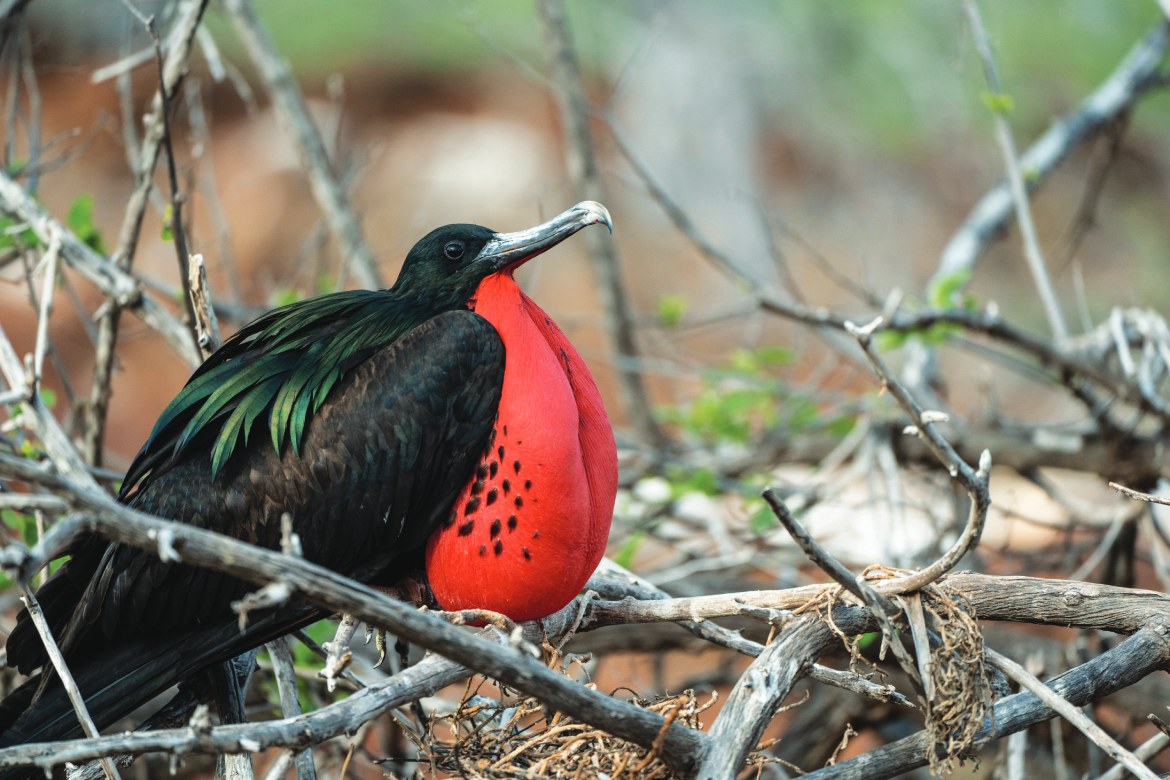
Male Frigate Bird (Photo by Emily Pennington)
I’ve spent the last five years becoming an expert in all things national parks. I’ve visited every Congress-designated park in the United States, and I’ve witnessed dozens of countries’ conservation strategies. The Galápagos Islands are truly unlike any protected area I’ve ever encountered. They are a rich tapestry of unique environments for both wildlife and geology lovers to discover as they explore with a guide. They are a place where, with the help of dedicated scientists and activists, humans have seemingly managed to rewind the clock and help endangered species begin to flourish again. The journey is far from complete, but concentrated efforts are helping tremendously, and that’s precisely what makes the islands so spellbinding.
As my last panga ride motored away from the small islet, I craned my neck skyward as the outstretched wings of boobies and frigate birds coasted along on the wind, heart swollen with gratitude for the brilliant souls who saved this place.


